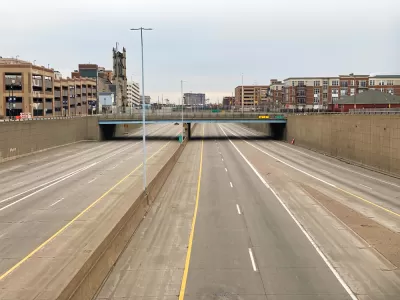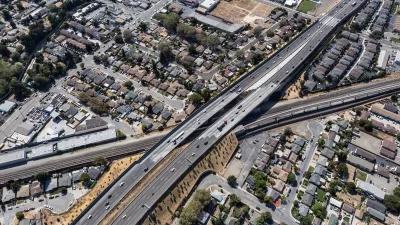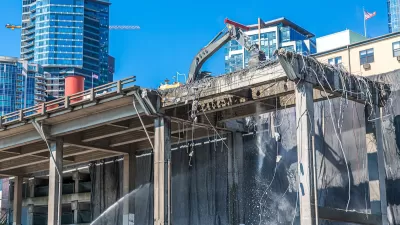In Michigan, the state's Department of Transportation is looking for ways to mitigate the damage caused by decades of urban renewal policies and reconnect neighborhoods cut off from amenities and opportunities by highway projects.

In response to criticism of the Biden administration's commitment to addressing the racism and discrimination built into U.S. roads, Nancy Derringer explains how roads and infrastructure can have disproportionately negative impacts on Black and brown communities, quoting Paul Ajegba, director of the Michigan Department of Transportation, who participated in a recent virtual panel on the issue. As Derringer writes,
Southeast Michigan is dotted with examples of roads and infrastructure that had the effect of dividing or demolishing neighborhoods populated by people of color. I-375, the spur that carries motorists from I-75 into downtown, is only the most obvious example. Built from 1959-65, it sliced through the footprint of the Black Bottom neighborhood, which had already been razed in the name of urban renewal. The generational wealth that was lost is incalculable, Ajegba said.
"Rather than top-down planning and development, today’s infrastructure design is more likely to be a collaborative effort that looks at nearby neighborhoods holistically, said Jon Kramer, another panelist and president of OHM Advisors, consultants who aid in such planning."
Planners are also recognizing the importance of multimodal transportation options and the need to replace car-centric infrastructure with safe, convenient facilities that benefit pedestrians, cyclists, and transit riders as well. Ajegba states that policymakers in Michigan have "a renewed emphasis on equity, inclusion and social justice."
FULL STORY: How can a road be racist? Don't ask that question in Michigan.

Planetizen Federal Action Tracker
A weekly monitor of how Trump’s orders and actions are impacting planners and planning in America.

Maui's Vacation Rental Debate Turns Ugly
Verbal attacks, misinformation campaigns and fistfights plague a high-stakes debate to convert thousands of vacation rentals into long-term housing.

San Francisco Suspends Traffic Calming Amidst Record Deaths
Citing “a challenging fiscal landscape,” the city will cease the program on the heels of 42 traffic deaths, including 24 pedestrians.

Amtrak Rolls Out New Orleans to Alabama “Mardi Gras” Train
The new service will operate morning and evening departures between Mobile and New Orleans.

The Subversive Car-Free Guide to Trump's Great American Road Trip
Car-free ways to access Chicagoland’s best tourist attractions.

San Antonio and Austin are Fusing Into one Massive Megaregion
The region spanning the two central Texas cities is growing fast, posing challenges for local infrastructure and water supplies.
Urban Design for Planners 1: Software Tools
This six-course series explores essential urban design concepts using open source software and equips planners with the tools they need to participate fully in the urban design process.
Planning for Universal Design
Learn the tools for implementing Universal Design in planning regulations.
Heyer Gruel & Associates PA
JM Goldson LLC
Custer County Colorado
City of Camden Redevelopment Agency
City of Astoria
Transportation Research & Education Center (TREC) at Portland State University
Jefferson Parish Government
Camden Redevelopment Agency
City of Claremont





























